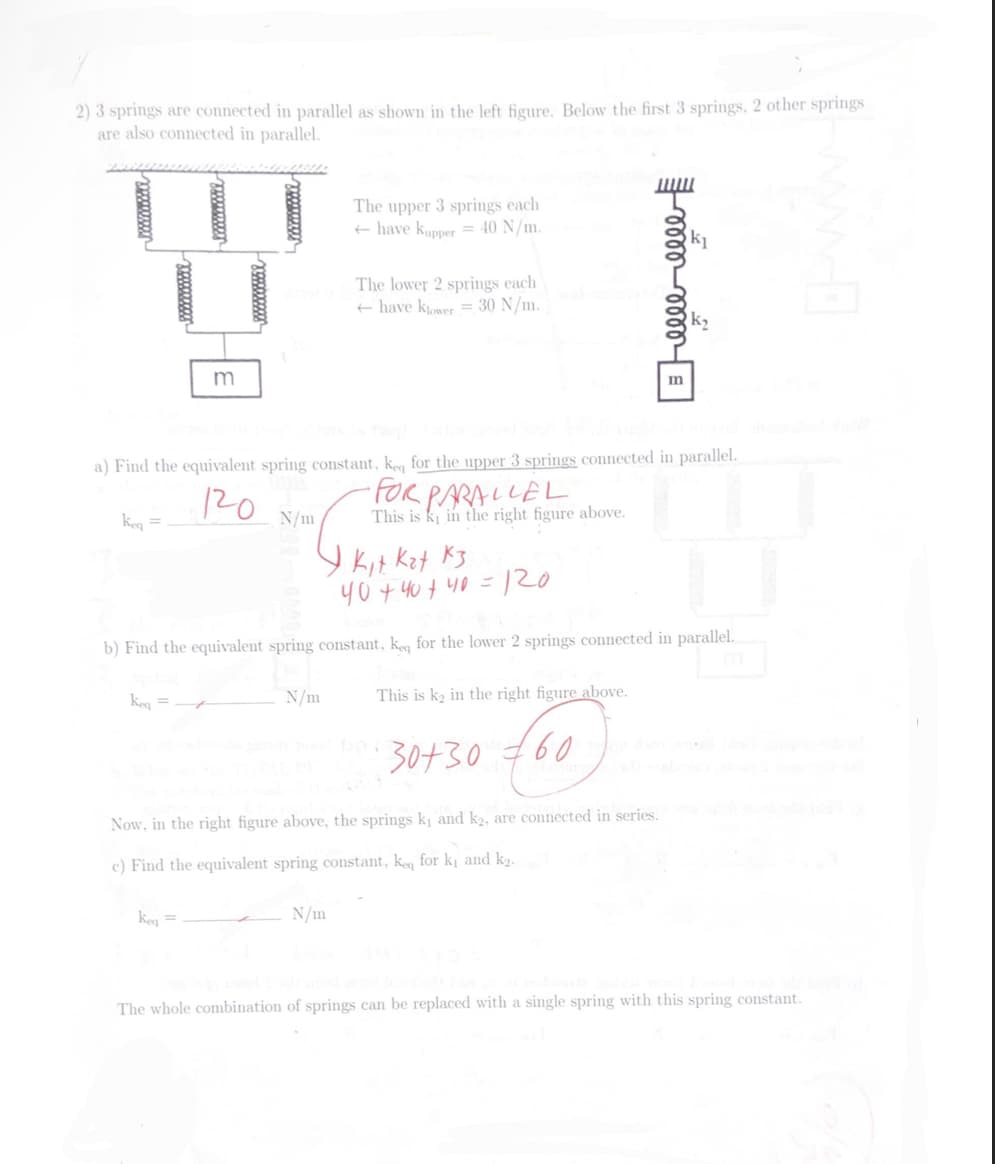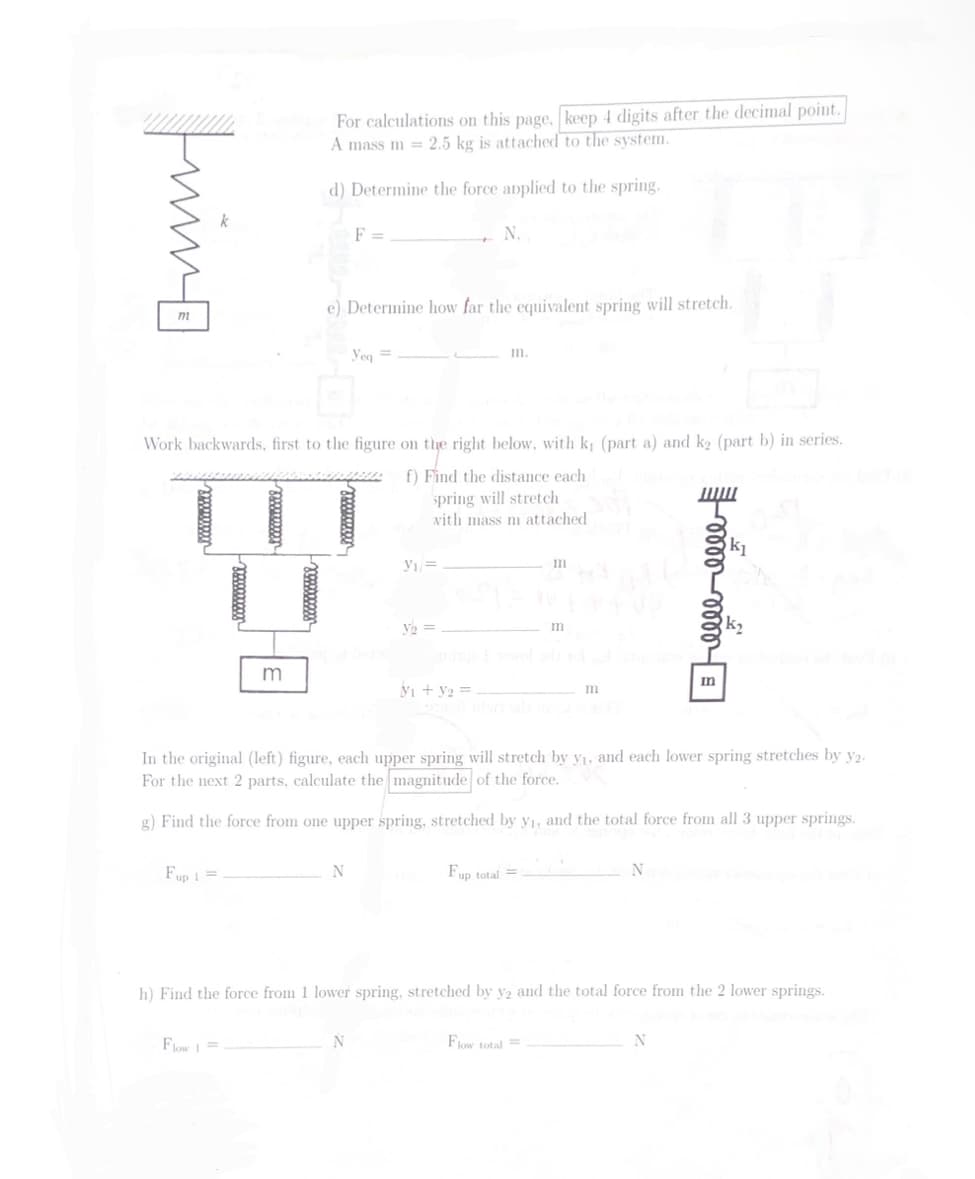3 springs are connected in parallel as shown in the left figure. Below the first 3 springs, 2 other springs are also connected in parallel. Keq = ********** keq mommy m Ken 2 120 N/m a) Find the equivalent spring constant, ke for the upper 3 springs connected in parallel. The upper 3 springs each have kupper = 40 N/m. The lower 2 springs each have klower = 30 N/m. N/m G 4 Kit kat k3 •FOR PARALLEL This is k in the right figure above. N/m 40 + 40 + 40 = 120 b) Find the equivalent spring constant, keq for the lower 2 springs connected in parallel. This is k₂ in the right figure above. 60 mmmmmm 30+30 Now, in the right figure above, the springs k, and k₂, are connected in series. e) Find the equivalent spring constant, keq for ki and k₂. m 5 44
3 springs are connected in parallel as shown in the left figure. Below the first 3 springs, 2 other springs are also connected in parallel. Keq = ********** keq mommy m Ken 2 120 N/m a) Find the equivalent spring constant, ke for the upper 3 springs connected in parallel. The upper 3 springs each have kupper = 40 N/m. The lower 2 springs each have klower = 30 N/m. N/m G 4 Kit kat k3 •FOR PARALLEL This is k in the right figure above. N/m 40 + 40 + 40 = 120 b) Find the equivalent spring constant, keq for the lower 2 springs connected in parallel. This is k₂ in the right figure above. 60 mmmmmm 30+30 Now, in the right figure above, the springs k, and k₂, are connected in series. e) Find the equivalent spring constant, keq for ki and k₂. m 5 44
Principles of Physics: A Calculus-Based Text
5th Edition
ISBN:9781133104261
Author:Raymond A. Serway, John W. Jewett
Publisher:Raymond A. Serway, John W. Jewett
Chapter6: Energy Of A System
Section: Chapter Questions
Problem 19P: A light spring with spring constant 1 200 N/m is hung from an elevated support. From its lower end...
Related questions
Question
This is one big question. Help please

Transcribed Image Text:2) 3 springs are connected in parallel as shown in the left figure. Below the first 3 springs, 2 other springs
are also connected in parallel.
keq =
xoxxxxxx
Keq =
wwwwww
m
keq =
a) Find the equivalent spring constant, keq for the upper 3 springs connected in parallel.
120
N/m
The upper 3 springs each
+ have Kupper = 40 N/m.
N/m
The lower 2 springs each
have klower = 30 N/m.
I. Kit. Kat Kз
40+40+ 40 =
b) Find the equivalent spring constant, keq for the lower 2 springs connected in parallel.
N/m
This is k in the right figure above.
டண்டண்
=120
This is k₂ in the right figure above.
30+30 €60
Now, in the right figure above, the springs k₁ and k2, are connected in series.
c) Find the equivalent spring constant, keq for k₁ and k₂.
The whole combination of springs can be replaced with a single spring with this spring constant.

Transcribed Image Text:Fring
Fup 1 =
xxxxxxxx
wawil
Flow =
For calculations on this page, keep 4 digits after the decimal point.
A mass m = 2.5 kg is attached to the system.
d) Determine the force applied to the spring.
m
Work backwards, first to the figure on the right below, with k₁ (part a) and k2 (part b) in series.
f)
Find the distance each
spring will stretch
with mass m attached
e) Determine how far the equivalent spring will stretch.
F
Dovol
Yeq=
N
N
Y₁ =
N.
y₂ =
₁ + y₂ =
m.
In the original (left) figure, each upper spring will stretch by y₁, and each lower spring stretches by y2.
For the next 2 parts, calculate the magnitude of the force.
g) Find the force from one upper spring, stretched by y₁, and the total force from all 3 upper springs.
Fup total =
m
m
Flow total =
m
N
h) Find the force from 1 lower spring, stretched by y2 and the total force from the 2 lower springs.
k1
k₂
N
Expert Solution
This question has been solved!
Explore an expertly crafted, step-by-step solution for a thorough understanding of key concepts.
This is a popular solution!
Trending now
This is a popular solution!
Step by step
Solved in 4 steps with 3 images

Knowledge Booster
Learn more about
Need a deep-dive on the concept behind this application? Look no further. Learn more about this topic, physics and related others by exploring similar questions and additional content below.Recommended textbooks for you

Principles of Physics: A Calculus-Based Text
Physics
ISBN:
9781133104261
Author:
Raymond A. Serway, John W. Jewett
Publisher:
Cengage Learning

Physics for Scientists and Engineers, Technology …
Physics
ISBN:
9781305116399
Author:
Raymond A. Serway, John W. Jewett
Publisher:
Cengage Learning

Physics for Scientists and Engineers
Physics
ISBN:
9781337553278
Author:
Raymond A. Serway, John W. Jewett
Publisher:
Cengage Learning

Principles of Physics: A Calculus-Based Text
Physics
ISBN:
9781133104261
Author:
Raymond A. Serway, John W. Jewett
Publisher:
Cengage Learning

Physics for Scientists and Engineers, Technology …
Physics
ISBN:
9781305116399
Author:
Raymond A. Serway, John W. Jewett
Publisher:
Cengage Learning

Physics for Scientists and Engineers
Physics
ISBN:
9781337553278
Author:
Raymond A. Serway, John W. Jewett
Publisher:
Cengage Learning

Physics for Scientists and Engineers with Modern …
Physics
ISBN:
9781337553292
Author:
Raymond A. Serway, John W. Jewett
Publisher:
Cengage Learning

University Physics Volume 1
Physics
ISBN:
9781938168277
Author:
William Moebs, Samuel J. Ling, Jeff Sanny
Publisher:
OpenStax - Rice University

An Introduction to Physical Science
Physics
ISBN:
9781305079137
Author:
James Shipman, Jerry D. Wilson, Charles A. Higgins, Omar Torres
Publisher:
Cengage Learning